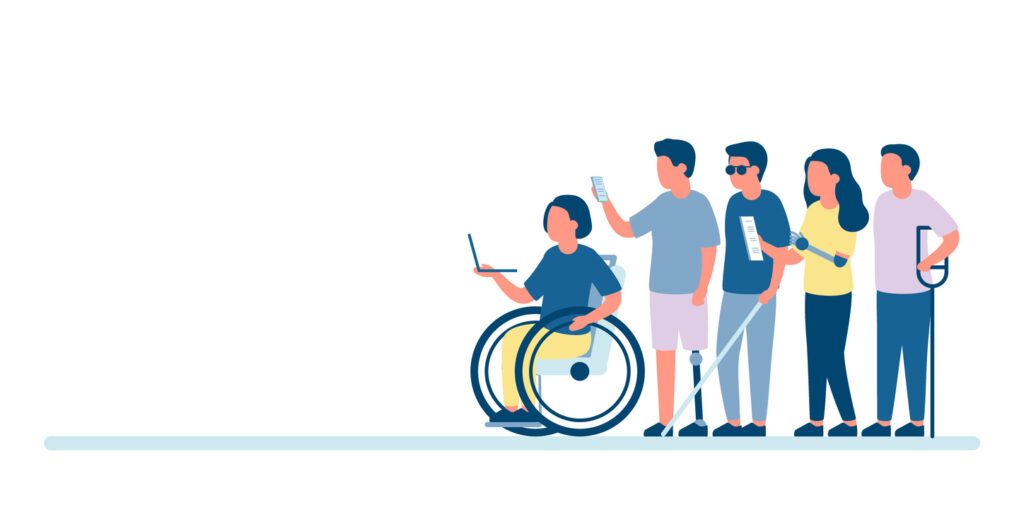Spotlighting Accessibility in Action: Building an Inclusive Workforce
October 3, 2024 in Diversity & Inclusion, IDEA, Recruitment & Retention, Selection & Assessment
By Shareen Drilling
This October is the 74th anniversary of National Disability Employment Awareness Month, which celebrates the many contributions of workers with disabilities to America’s workplaces and economy. While this takes place annually, its purpose is to reinforce a commitment to ensuring workers with disabilities have access to great jobs all year round. This blog will highlight practices employers can take to increase accessibility inclusion in the workplace and examples of organizations that are implementing those practices.

Inclusive Strategies
Many organizations are focused on providing guidance and resources to companies so they can implement inclusive strategies and programs, including the Employer Assistance and Resource Network on Disability Inclusion (EARN), which offers services that help employers recruit, hire, retain, and advance workers with disabilities. EARN promotes a specific framework, Inclusion@Work, developed in partnership with the Department of Labor, which outlines seven components of a disability-inclusive workplace:
- Lead the way by building an inclusive culture
- Build the pipeline through outreach and recruitment
- Hire (and keep) the best through talent acquisition & retention processes
- Ensure productivity by offering reasonable accommodations
- Communicate company policies and practices (internally and externally)
- Be tech savvy with accessible information and communication technology
- Measure success through accountability and self-identification
In addition to leveraging a framework like Inclusion@Work, organizations can consider some of the following inclusive practices to recruit, hire, retain, and advance employees with disabilities:
- Recruit
- Use inclusive language in all messaging, outreach, and job announcements
- Confirm any online applications are accessible
- Post job announcements on accessible job-boards
- Be proactive in searching for qualified candidates with disabilities by partnering with other organizations
- Hire
- Allow candidates to request a reasonable accommodation during the interview process
- Inform candidates how the interview will be structured in advance of the interview
- Confirm all onboarding processes and materials are accessible and inclusive
- Involve existing employees with disabilities in onboarding activities
- Retain
- Offer workplace flexibility, including remote work options
- Create a culture that supports mental health
- Develop retention plans based on feedback collected through any surveys and exit interviews
- Advance
- Offer training and career development opportunities, including on-the-job training, developmental assignments, job shadowing, mentoring, and coaching
- Confirm no barriers exist for employees with disabilities to be able to participate in developmental opportunities and include language about reasonable accommodations
There are countless benefits to implementing accessibility inclusion strategies, including increased innovation thanks to a more diverse talent pool, as well as higher productivity and employee engagement because employees feel motivated and valued. A recent study by Disability:IN and Accenture in 2023 reported organizations that led in disability inclusion also saw an increase in revenue, net income, and profit.
Accessibility Inclusion in Action
The following are example organizations that are working to increase the hiring and retention of individuals with disabilities, demonstrating their commitment to building an inclusive workforce.
- Recruit:
- MetLife recruits student interns with disabilities through the Emerging Leaders program at the National Business and Disability Council (NBDC), providing students the opportunity to gain work experience and for MetLife to gain access to a new pipeline of talent.
- Hire:
- FMP Consulting has taken several steps to improve accessibility in our selection system to ensure our interview process suits the needs and strengths of all candidates, allowing for a fair and inclusive evaluation of their skills and potential.
- Retain:
- Accenture has worked to create a barrier-free workplace to support their workforce across the world by implementing a multi-year plan to remediate their technology to be more inclusive.
- Advance:
- Disability:IN offers the NextGen Leaders program, which matches college students and recent graduates with mentors from over 400 different companies across various industries, including Google, JPMorgan Chase, Boeing, and Pfizer.
Employers that commit to creating an accessible and inclusive workplace need to incorporate it into every phase of the employee life cycle: recruitment, hiring, retention, and advancement. More importantly, leaders and executives should model behavior and reinforce the commitment to building a workforce and fostering a culture that is inclusive of everyone, including individuals with disabilities.

Shareen Drilling joined FMP in November 2018 and is a Consultant in the Learning and Development Center of Excellence (L&D COE). Shareen is also a DHS Section 508 Trusted Tester and passionate about developing accessible and inclusive training solutions. When Shareen isn’t designing training content or facilitating workshops, she enjoys trying new recipes in her kitchen, spending time outdoors, and hanging out at home with her husband, son, and two cats.